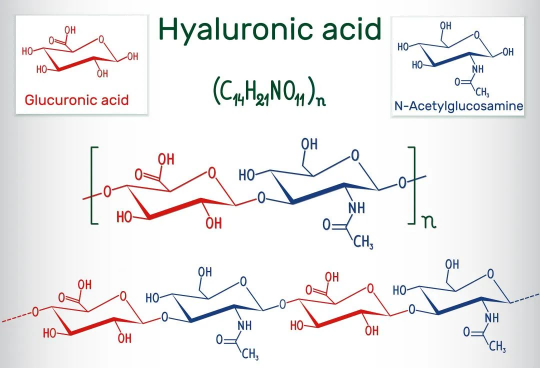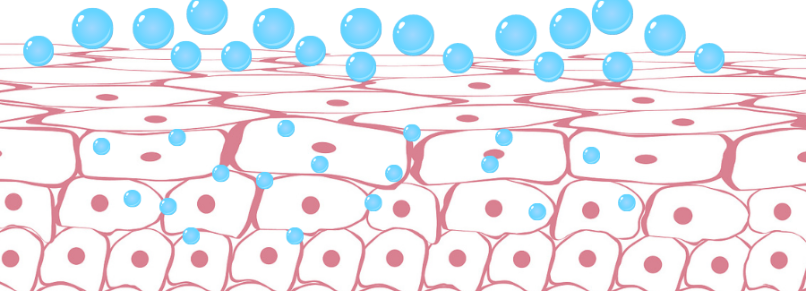Hyaluronic acid moisturizing effect is well known worldwide. Hyaluronic acid is essentially an acidic mucopolysaccharide, an indigenous inhabitant of our bodies. The hyaluronic acid family can be found in the vitreous body, synovial fluid, connective tissue and dermis, among many other places, where they build a reservoir and play a very important role in water retention.
However, it was first isolated from the vitreous humor of the bull’s eye. The first application was in the 1950s, when it was used as an adhesive in eye surgery. Later on, scientists developed some derivatives of it, which were then used in different medical fields. As for its popularity in the skincare world, it’s only been in the last two decades or so.
Hyaluronic Acid Moisturizing Effect
Hyaluronic acid has been in the body since birth and is a natural moisturizing factor. It has a strong ability to hold onto water and can carry many, many times its own weight in water. It is probably the best moisturizing substance found in nature. It has a large number of hydroxyl groups in its molecular chain, which can combine with the H-bonds in the water molecules to form a huge net that locks the water firmly in place and doesn’t let any of the water molecules escape. This is why hyaluronic acid moisturizing effect is very powerful.
 Hyaluronic acid molecular structure
Hyaluronic acid molecular structure
Hyaluronic Acid large, medium, small molecular weight
According to its structure, hyaluronic acid can be categorized into large molecular weight, medium molecular weight and small molecular weight.
However, it is the small molecular weight hyaluronic acid that can penetrate the skin and go straight to the base of the skin. They can penetrate into the dermis, deeply hydrate the skin, improve the skin’s water holding capacity, and increase the skin’s elasticity. Medium and large molecular weights are arranged to “guard the door” due to their large size, forming a protective film on the surface of our skin, and small molecular weights work together both inside and outside, on the one hand, deeply nourishing the skin, and on the other hand, meticulously guarding the water molecules that are captured on the surface of the skin. In addition, hyaluronic acid itself is also an important component of the skin, with the function of epidermal tissue repair. Many skincare products have sodium hyaluronate added inside in three molecular weights: large, medium and small to achieve the best hyaluronic acid moisturizing effect.
 Small molecular weight hyaluronic acid enter skin to hydrate;
Small molecular weight hyaluronic acid enter skin to hydrate;
large molecular weight hyaluronic acid help skin to hold water.
Hyaluronic Acid for Anti-aging
When it comes to anti-aging, the first thing that comes to mind is collagen and elastin. In fact, as we age, collagen, elastin and hyaluronic acid are all lost, leading to skin aging.
Loss of hyaluronic acid causes sagging and lack of moisture in the skin. Hyaluronic acid supplementation can effectively hydrate the skin tissue cells and make the dried out epidermal cells full again.
It is like the load-bearing wall of a house, holding up our skin and forming a large net on the surface to firmly lock in moisture. At the same time the water molecules it catches in also keep the elastin fibers and collagen in a moisture-filled environment, giving them nourishment and comfort, it will make our skin look more elastic.
What’s Sodium hyaluronate?
Sodium hyaluronate is the sodium salt of hyaluronic acid, which is more stable in nature and a bit more penetrating, and is one of the most common in cosmetic ingredient lists.
Hyaluronic Acid QA
Q1 The higher the concentration of hyaluronic acid, the better?
No, due to its chemical structure, hyaluronic acid has a high molecular weight and strong water absorption ability, so products with more hyaluronic acid will have a relatively thicker texture. The concentration of hyaluronic acid in common hyaluronic acid-rich products on the market generally does not exceed 1%.
Q2 Is it better to have more types of hyaluronic acid?
No, the more types of hyaluronic acid there are, the better the product.
The application of different types of hyaluronic acid is determined by the positioning of the product. Different combinations have different effects.
Q3 Is it necessary to build up tolerance to hyaluronic acid?
No, it is not necessary.
Although hyaluronic acid has the word “acid” in its name, it is actually a polysaccharide and is generally suitable for all skin types and does not require tolerance building.
As an efficacious cosmetic raw material, hyaluronic acid has been widely used in skin care masks, toners, creams, lotions, essence products and hair care products and facial cleansers and other cosmetics. The amount added is generally between 0.01% and 0.5%, and the amount added for special-purpose cosmetics can be as high as 0.5% or more. Usually, anti-aging products and sunscreen cosmetics should choose HA with high molecular weight, generally with molecular weight above one million, and the dosage should be within 0.1% to 0.5%; while lotion essence, masks, and other products mainly utilize the permeability of HA, so they should choose low molecular weight HA, with molecular weight between 100,000 and 500,000, and the dosage is generally between 0.01% and 0.5%. Nowadays, after a lot of researches, HA with different molecular weights can be used in various products, which can show the comprehensive effect of HA. Since hyaluronic acid is a straight chain polymer polysaccharide, in the field of cosmetics, hyaluronic acid moisturizing effect is excellent, and at the same time, it can repair the damaged cells, so that they can be restored.







